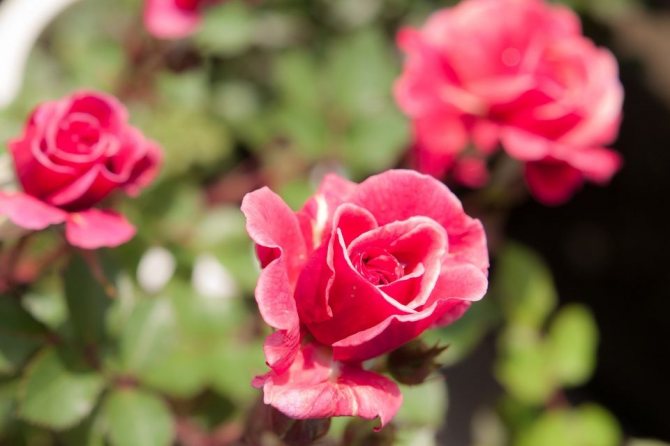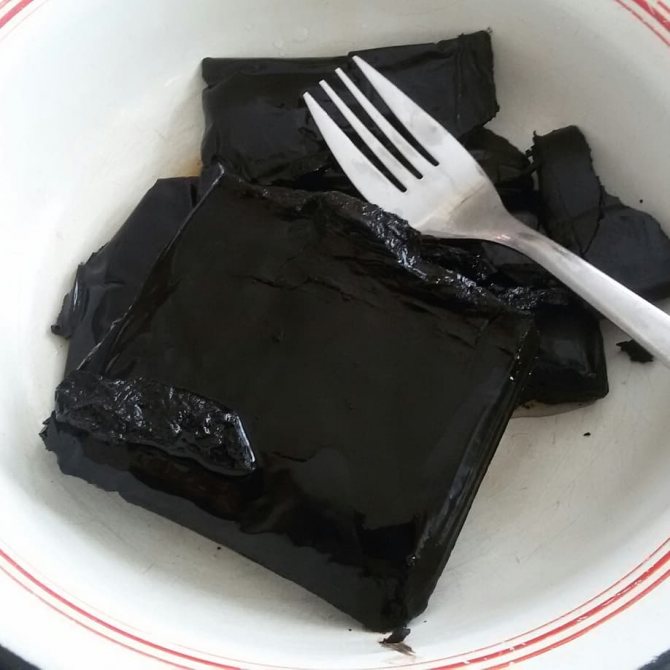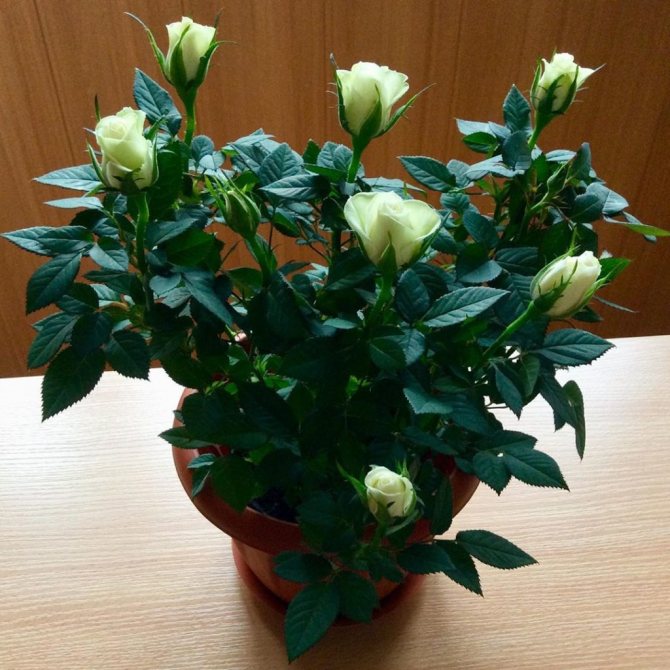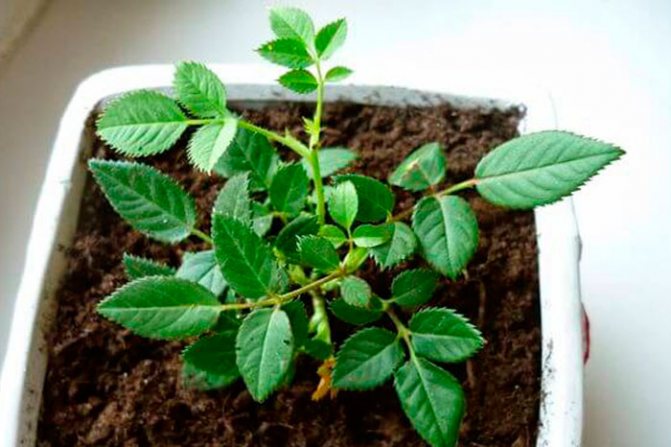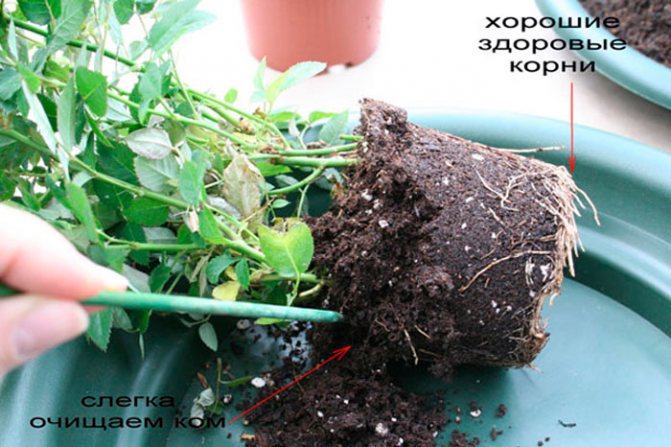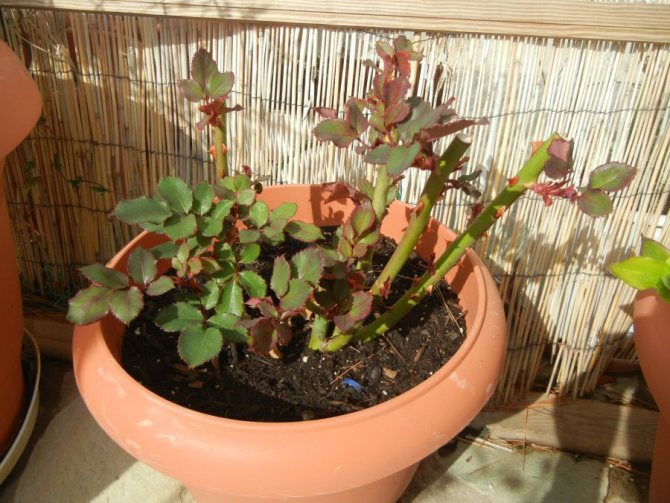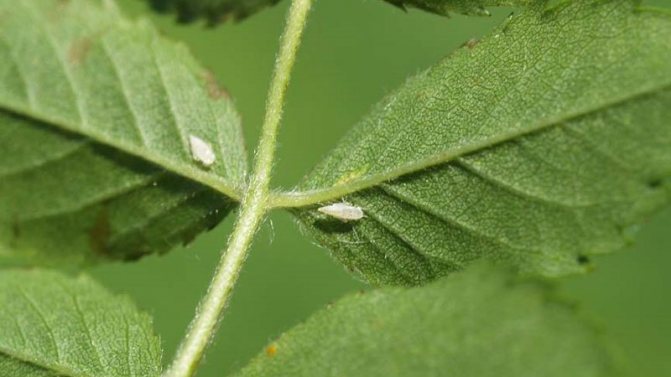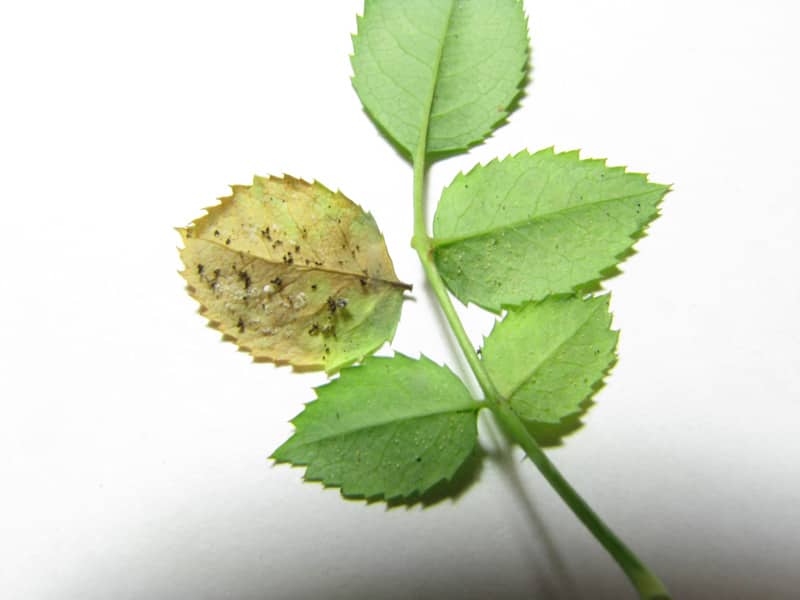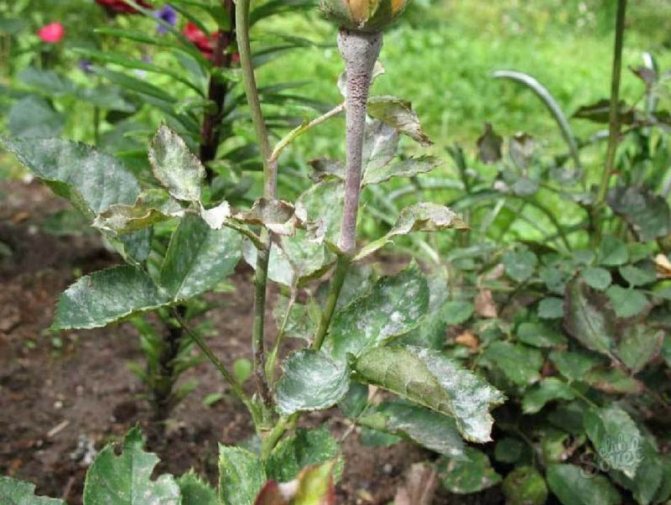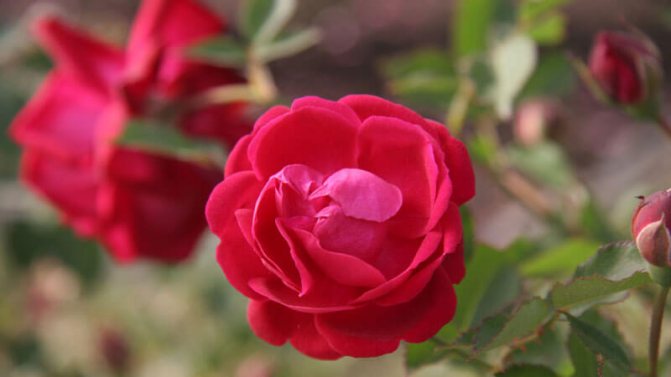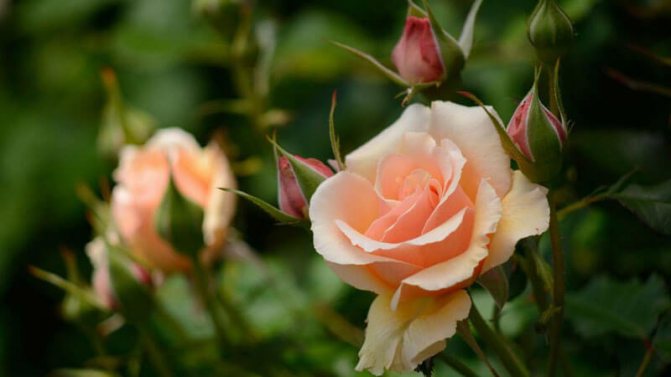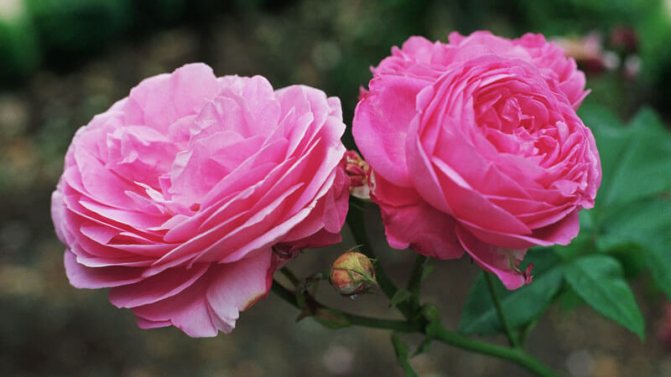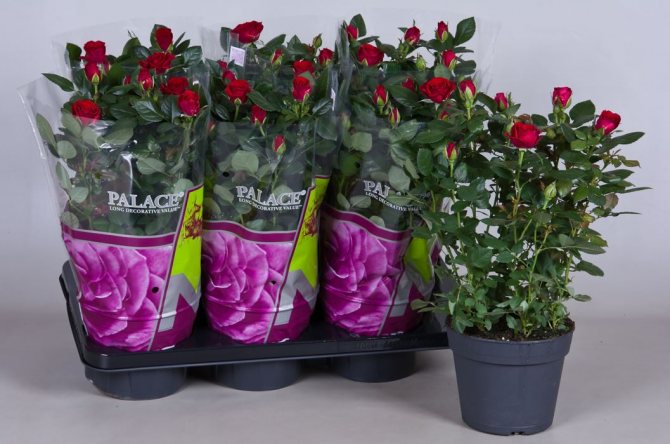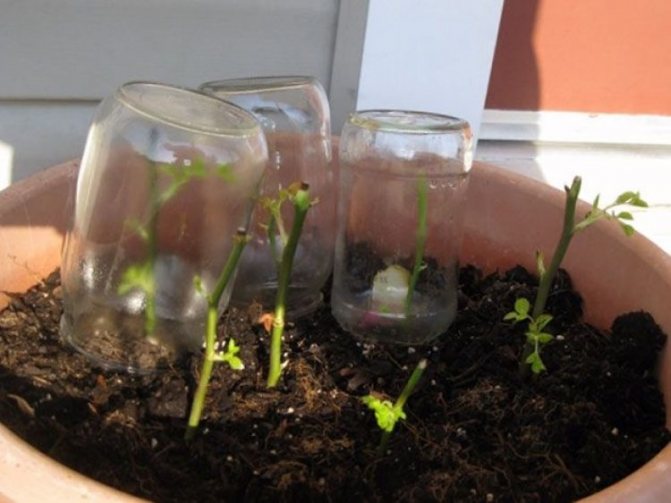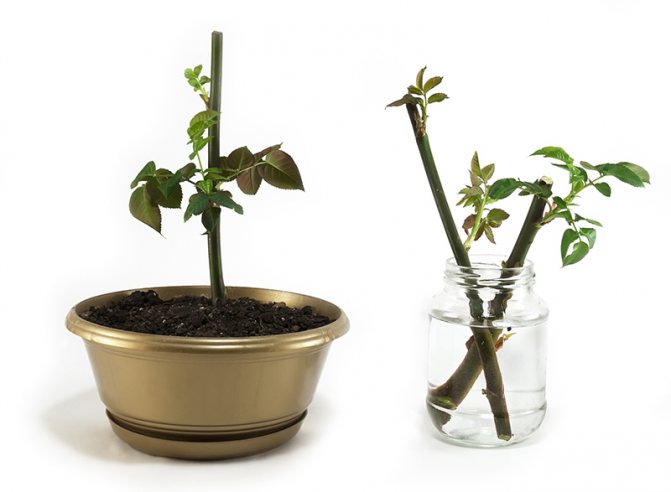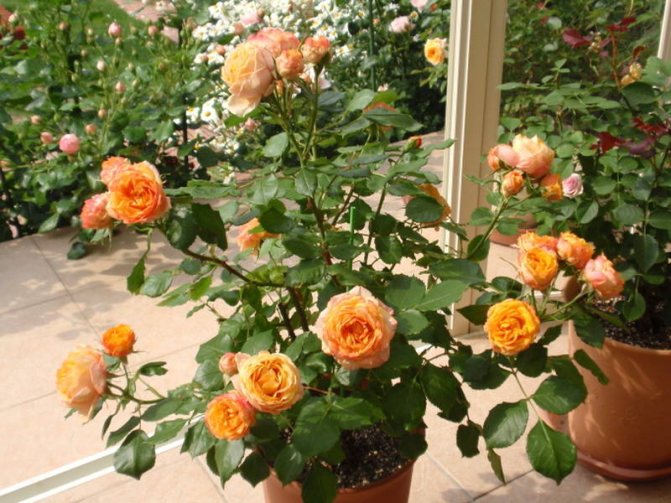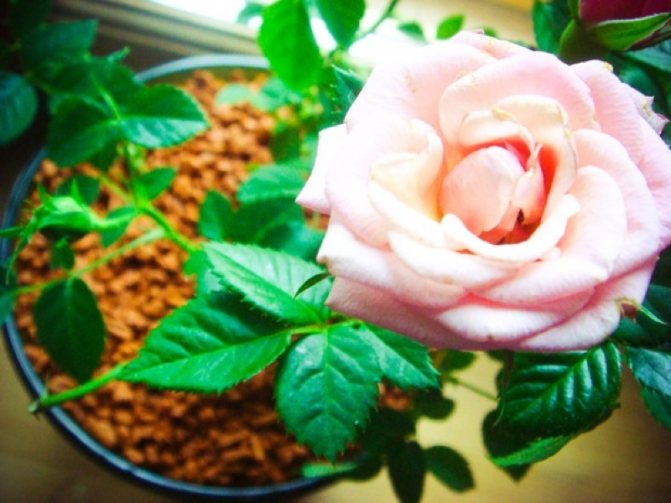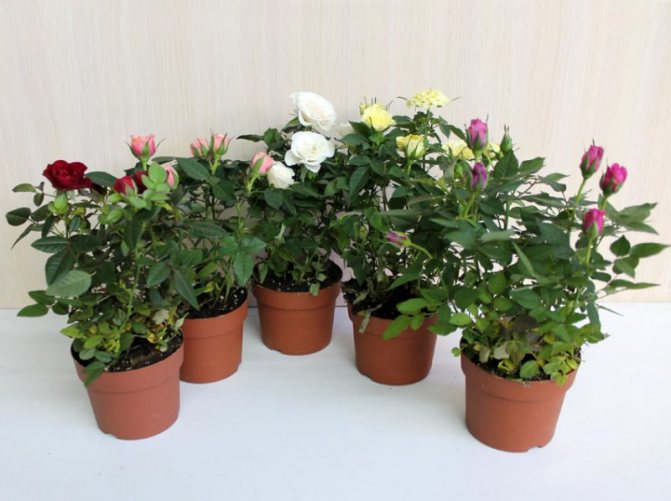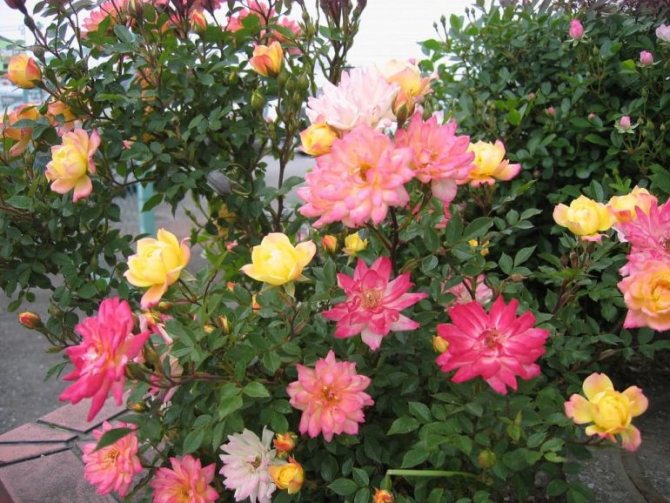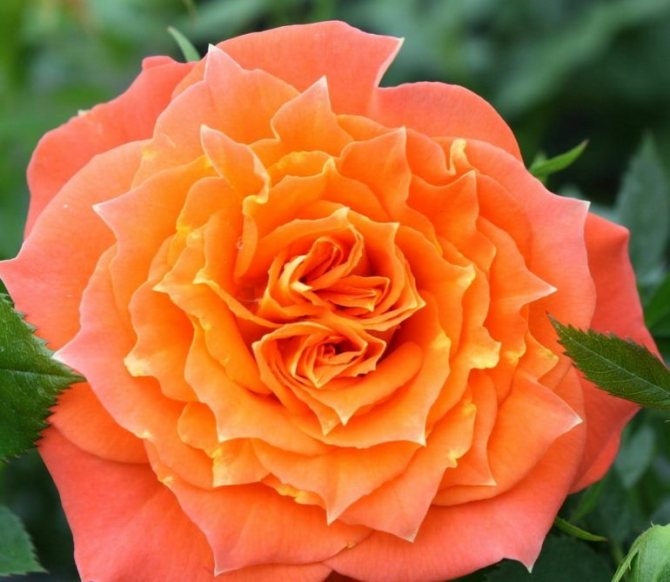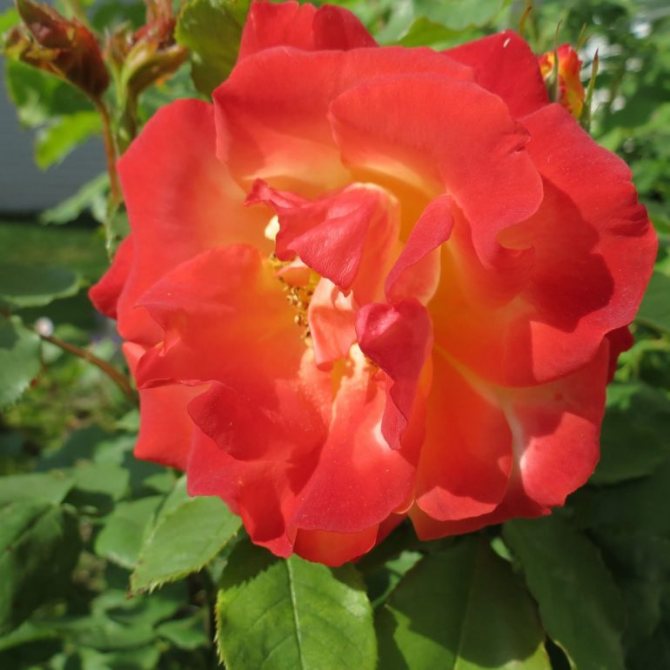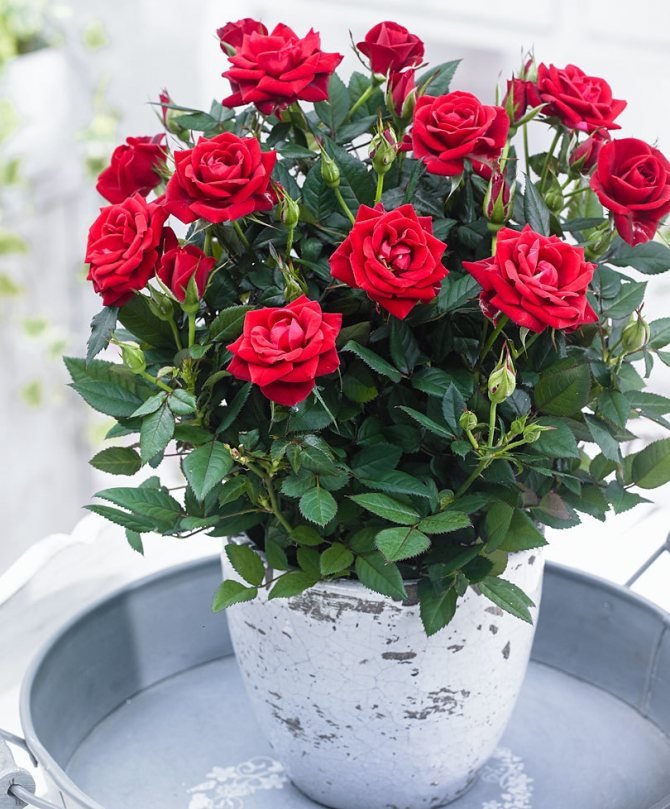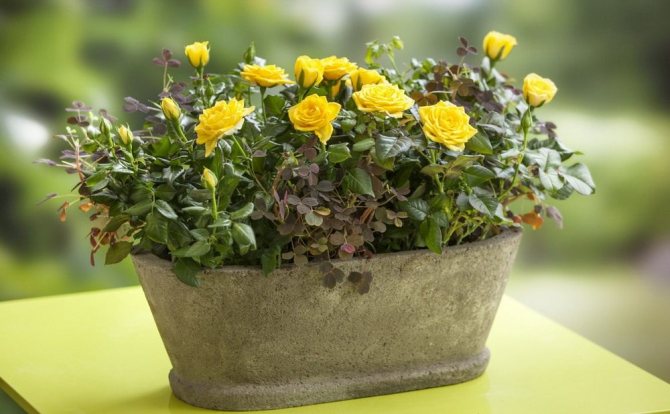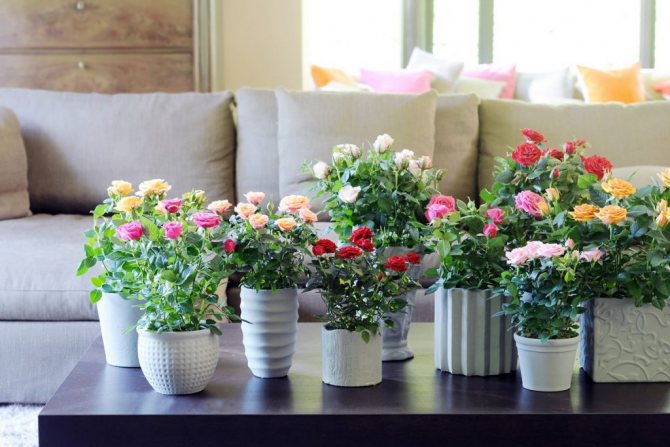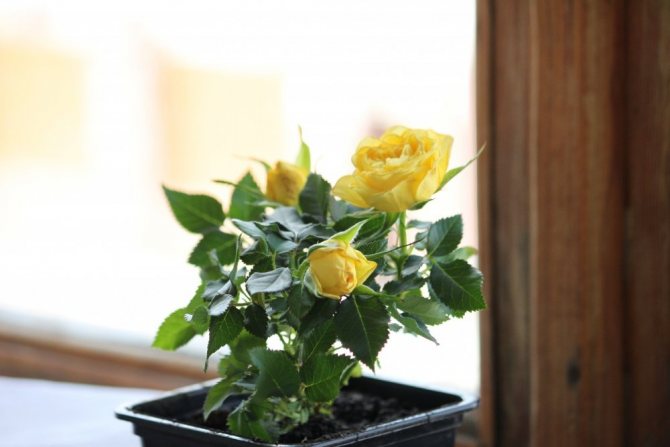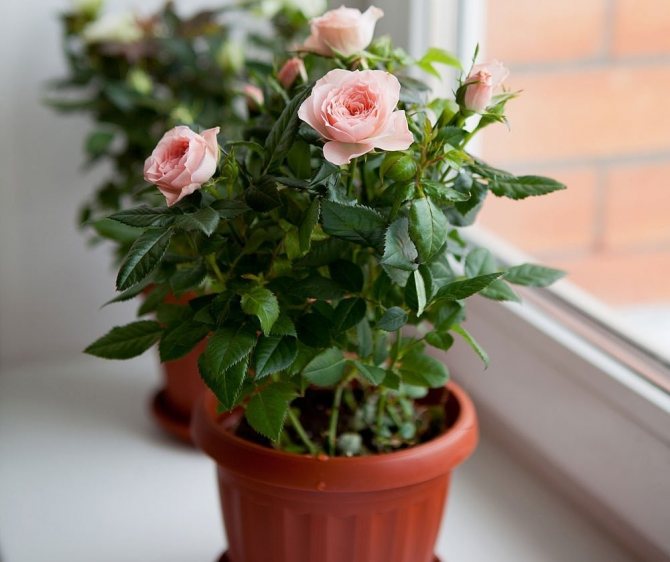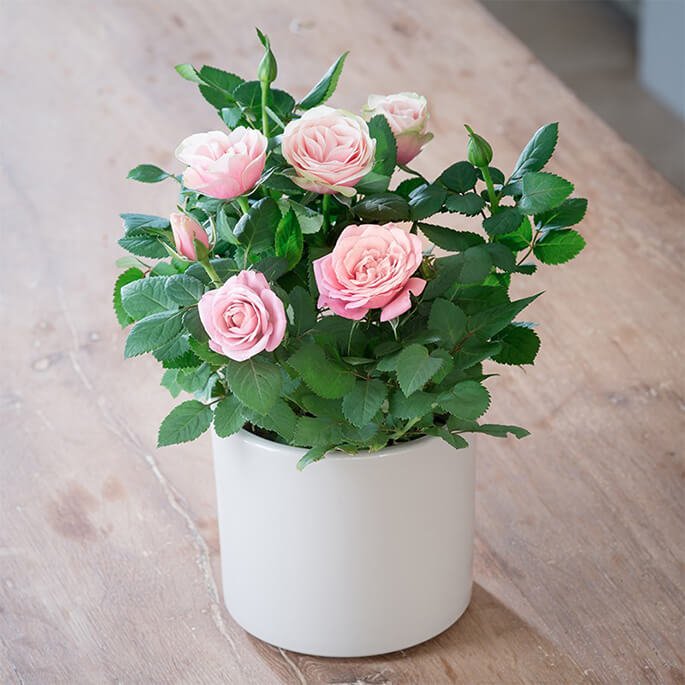Since ancient times, the rose has been considered the queen of flowers. And this is right, because she is so refined and graceful, and the delicate aroma of her flowers leaves no one indifferent. Indoor rose, grown in a pot, is the ultimate dream of lovers of home flowers.
Home care for a room rose considered difficult, but for those who want to see such beauty on their windowsill, nothing is impossible.
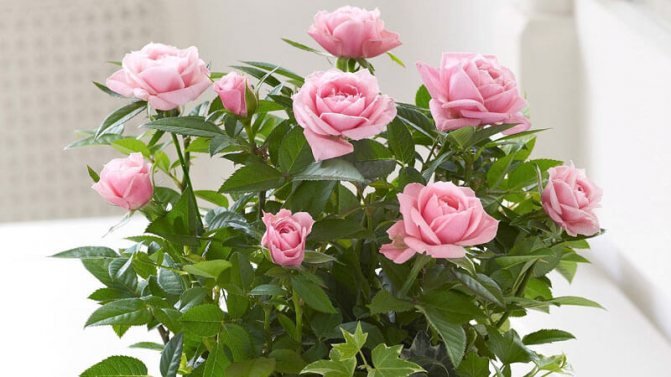
There is a similar article on this topic - Roses: planting and care. Varieties and types of roses.
First steps immediately after purchase
First of all, you need to wipe the leaves with warm water in order to prevent pests and diseases. This manipulation is done even if there are no signs of infection on the rose. As a solution, you can choose ordinary soapy water, and you can also use the finished preparation of Aktara.
You should not transplant the flower on the first day after purchase. The rose must get used to new temperature conditions, room humidity and lighting. After 4-5 days, the flower can be "moved" to a new pot. In order for the plant to be healthy, strong and pleasing with abundant flowering, you need to take into account the size of the flower itself and the pot, the type of soil. And in the future, follow the rules of watering and feeding.


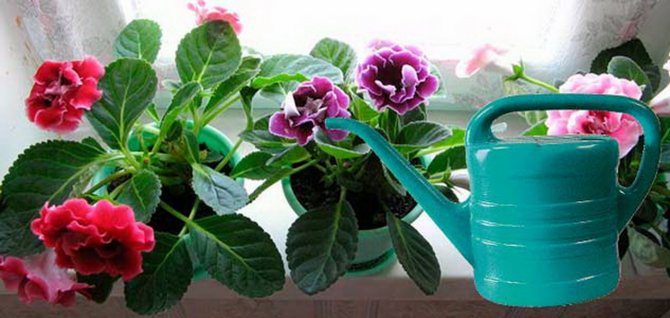

The need to take care of a purchased flower
Usually indoor roses are sold at the age of 2-3 months., that is, they are not yet fully strengthened and rather weak. Moving, a new environment, adaptation to it and to a new unusual microclimate is a rather stressful period for such a fragile flower that will need proper care more than ever.
It is equally important to choose a healthy plant, because even professionals in the world of floriculture can hardly "come out" with a problem flower. To choose a healthy flower, first of all, it is worth checking the leaves: they should be green, without yellowness, white, black or brown dots and not withered.
The plant rehabilitation period lasts about 2-3 weeks from the date of purchase., this is the most difficult period for a flower, and after 1.5 months the rose fully adapts, comes to its senses and is ready to bloom again.
Reference! During the adaptation period, indoor rose can shed leaves, buds and flowers. This is considered normal as the flower adapts to the unusual microclimate.
Pot selection and soil preparation for replanting
To provide optimal care for a rose in a pot at home after buying it in summer or autumn, the first step is to choose the right container - buy a ceramic or plastic pot. It is important to pay attention to its size, the diameter of the container should be 5-6 cm larger than that in which the rose grew at the time of purchase.
Height is not taken into account, since due attention is paid only to the width, which is due to the peculiarities of the root system of the plant. As soon as the issue with the pot is resolved, you need to take care of the soil.


A qualitative composition should include the following substances:
- humus (approximately 40% of the total amount of the substrate);
- sod soil (the same amount as humus);
- sand (the remaining 20%).
All components can be bought in a specialized store, and then mixed thoroughly.You can also buy a ready-made substrate for growing decorative roses. It is important to take care of the drainage system; for this, expanded clay or small pebbles are poured onto the bottom of the container, about 2-3 centimeters.
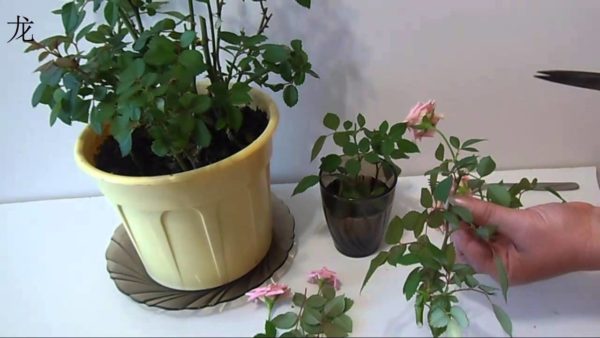

Advice from a florist!
Do not buy a cheap potting mix, it contains a lot of peat, but there are very few nutrients. Unscrupulous manufacturers in this way reduce the price of the product, and the rose may die.
How to care in winter


At rest, you need to reduce watering
The winter season is a dormant period for a rose, requiring changes in its maintenance regime. The plant is transferred to a cool place where the temperature is in the range of 6-8 ° C. Since the apartments are heated at this time of the year, the best place is a glassed-in balcony or loggia.
The culture should be in warm soil. For this, the pot is placed in a box with sawdust. It is necessary to regularly monitor the temperature level in the room where the plant is located. If the indicator drops below 6 ° C, the rose should be transferred to a warmer place. Watering is carried out rarely, only when the soil dries out.
Important! Spraying is not performed in winter.
Rules for transplanting a decorative rose
Remove the plant from the old container along with the soil. Examine the root system carefully, as a rule, it should tightly braid the soil. If the roots are brown, dry and hair-like, then the flower may not take root. So that in the future, caring for a rose at home will bring a good result, you can try to cut the cuttings and root them right after the purchase.
A bright white or yellowish shade of the root system indicates that the rose will be able to survive the transplant. If the roots are dry or partially disappeared, then the damaged parts are removed. Place the shrub along with the old soil in a new container. Sprinkle with substrate on top. To prevent the plant from dangling, it must be fixed by compacting the soil.
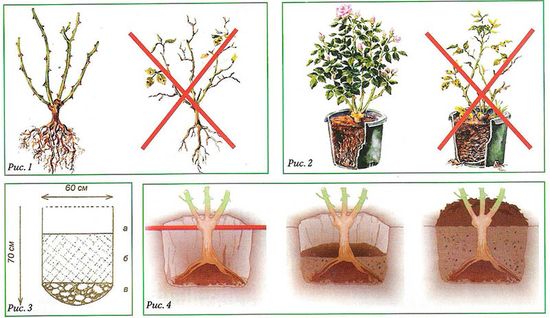

After that, the flower must be watered abundantly with warm and pre-filtered water. Considering the factor that the plant has been on the store shelf for some time, it needs to be treated with a special preparation Epin. Thanks to this tool, the plant will get stronger and will be able to survive stress after transplanting without any problems.
Next, the transplanted rose must be placed in a well-lit place, but only make sure that direct sunlight does not fall on the flower. Caring for a rose in a pot at home requires the right approach to choosing a place, especially after buying it in winter. At this time, there is insufficient lighting, so you can use special fluorescent lamps.


Possible problems
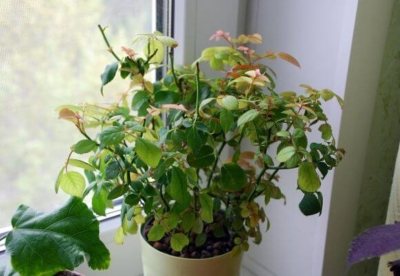

- Rose is a tasty morsel for many pests. Most often, spider mites annoy. The appearance of this parasite is signaled by dots on the leaves, like from a needle prick, a cobweb appears on the processes. The leaves turn yellow and fall off.
How to save a rose growing in a pot? For the tick, the most popular drug is Fitoverm, the plant is sprayed with its solution and the soil is soaked. The procedure is repeated 2-3 times with an interval of 7-10 days. This trouble appears due to a lack of moisture, so frequent bathing is good for prevention. - Buds and young shoots suddenly began to deform, curl and dry out, take a closer look. Have you seen small insects? It's aphid. Do not hesitate, treat the sweet with soapy water. From chemistry - preparations containing Karbofos.
And here's another fun remedy: if there are few aphids, you can bring and plant several ladybirds on the bush, wishing them bon appetit. - The leaves are covered with dark spots. They began to turn yellow and fall off. The rose has a fungal disease. This happens from excessive humidity. For example: under the packaging film in the store, when water gets on the leaves during watering (watering is necessary on the ground, not the whole plant).
Infected leaves should be removed and treated with fungicidal preparations. Fitosporin was mentioned above. - Powdery mildew may appear if the plant has been exposed to extreme temperature changes (cold nights after warm days). Leaves and buds are sprinkled with white powder. Treatment: destroy the damaged parts of the plant and again - fungicidal preparations.
- Leaves have yellow stripes or spots. It could be bacterial cancer. The roots and the lower part of the flower are rotting. The rose will have to be dug up and destroyed, since there are no chemical control agents. Do not use the contaminated ground again.
- The rose is sad: the buds wither, the leaves dry and fall off - all this may indicate care errors (why does a room rose discard leaves and buds and dry up?). If the shoots dry up - underfilled and dry air. We will reanimate urgently! It is necessary to remove dried branches up to 3-4 cm from the trunk. Water and place the rose pot in a tray filled with water. Or we build a greenhouse from a plastic bag.
It is worse if the branches of a sad rose do not dry, but rot. This is an overflow. And salvation is a transplant into a new land with the removal of rotten roots.
Changing living conditions, cold and hard water for irrigation, overheating in summer, dry air in winter, spraying and watering in a cold room, cramped pot, uncleared wilted flowers ...Learn to "hear" and understand your rose... And she will certainly thank you!
... So in our house year after year goes, And in the house a beautiful rose grows. She is not a flower, but a wonderful child, She smiles even asleep, She is as good as all the roses in the garden, That just blooms every month of the year!
Pruning
As a rule, the decorative rose is cut only before preparation for the winter period. This grooming manipulation is done with a pair of garden shears or pruning shears. The tool must be sharpened, the correct pruning of the plant will depend on this. All damaged, crooked, dry, lethargic and thin shoots must be removed. The cut is made at an angle of 45 degrees, about 0.5 cm above the kidney.


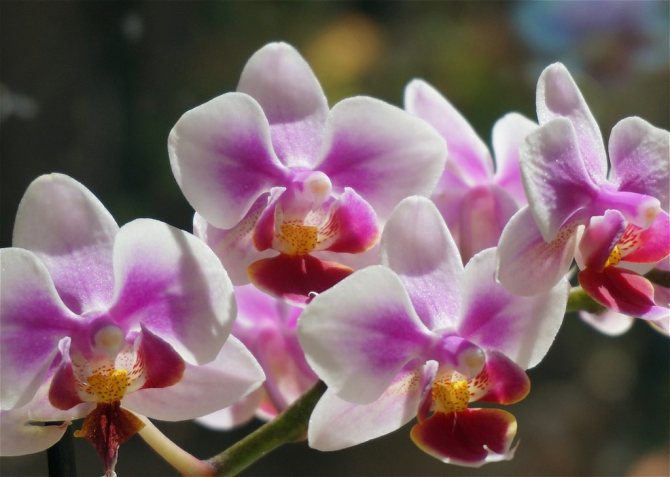

Diseases and pests
The following diseases and pests can affect a home rose:


Chlorosis. You can recognize it by the yellowness on the leaves. Iron chelate is used to treat it.- Powdery mildew. It is characterized by the presence of white spots on the leaves and stems. For treatment, fungicides are used.
- Spider mite. It leaves a thin cobweb between the leaves. If you do not start fighting this pest, then it will provoke viral diseases. For treatment, it is effective to use Apollo or Fitoverm.
- Thrips and aphids. These insects infect buds and leaves, leading to their deformation. For treatment, insecticidal preparations intended for indoor plants are used.
Room rose care rules
For the flower to be beautiful, it is important to follow the care recommendations.
Watering
It is important for miniature roses to ensure proper watering immediately after transplanting into a new pot. The soil should not be allowed to dry out, but it is also forbidden to flood the plant with water. As a rule, they are guided by the top layer of the soil whether a room rose needs watering. Caring for a rose in a pot at home is especially important after buying a flower in the summer.
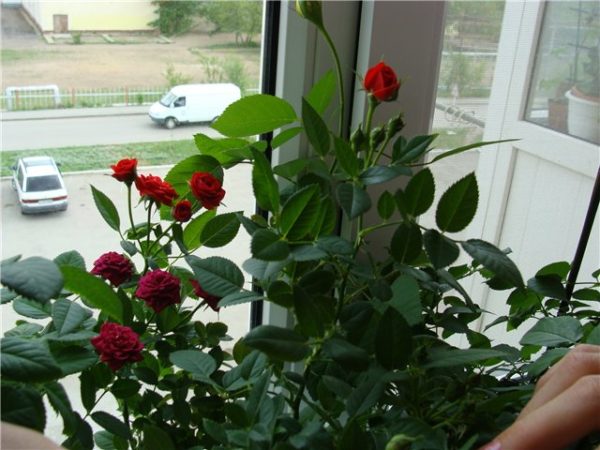

The fact is that at this time of the year, bud development usually takes place. Also, such roses do not tolerate sudden temperature changes, so the water must be preheated or kept indoors. As for spraying, the plant is very fond of such care.
Using a spray bottle, you need to spray the rose leaves several times a day in the summer and once in other seasons. During the dormant period, and for a rose this is autumn and winter, the flower should be watered with cool water. But it is important to reduce the number of watering several times.Experienced growers even advise that the soil be a little dry, but no more than two days.
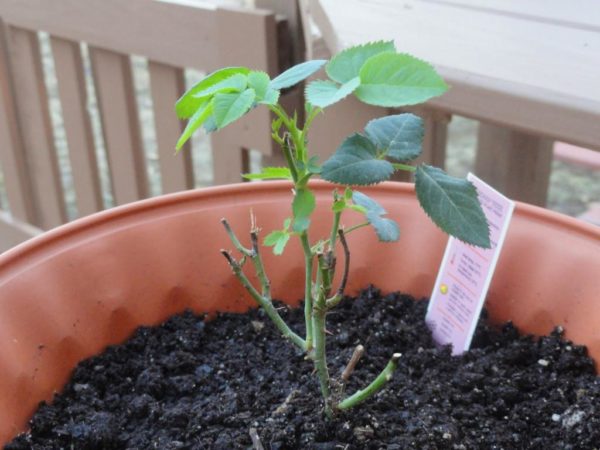

Lighting
Indoor rose refers to light-loving plants. That says it all. In order for it to be healthy, strong and pleasing with abundant flowering, you need to choose places where there is a lot of light. Despite this, direct sunlight can burn leaves and buds. The best places for the pot would be southeast and southwest windows. Additional lighting is required in the winter season. You can choose a fluorescent lamp as the backlight.
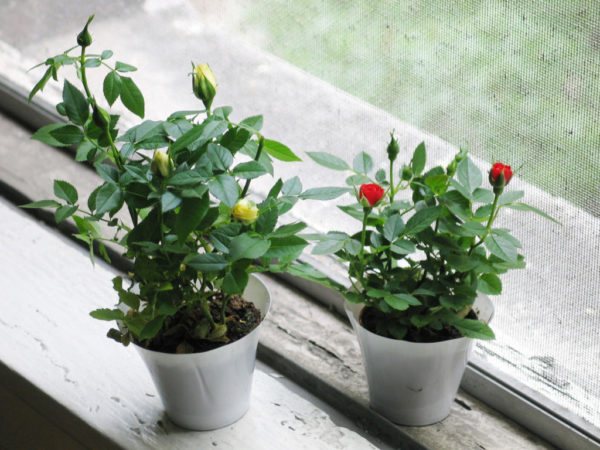

Temperature regime
The optimum air temperature for a plant in the flowering stage is 20-25 degrees. But do not forget that the rose is a flower that loves fresh air. Therefore, for full growth, it is necessary to organize such conditions for her. In the warm season, the pot with the plant must be taken out into the street or onto the balcony.
Air humidity
It is forbidden to place a container with a rose next to heating devices. The room should have a humidity of 50-60%. But the conditions corresponding to a subtropical climate will provoke the development of fungi and rot, which will lead to the death of the plant. The rose loves moisture, so it needs to be sprayed daily, you can also put a separate container with water next to the pot, it will evaporate, and the plant will be able to take the right amount of moisture.
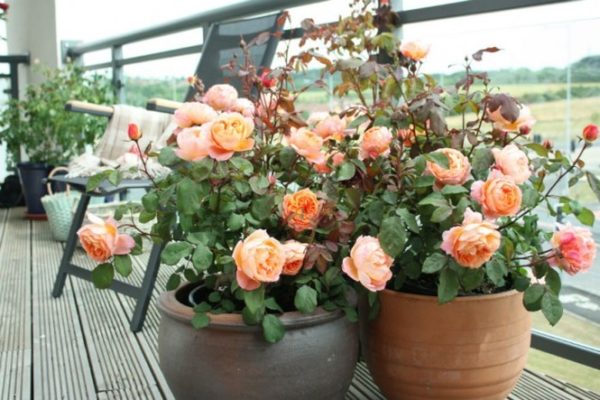

Top dressing
Caring for a rose in a pot at home includes mandatory feeding. Immediately after purchase, you need to transplant the plant, but feeding is optional. It is necessary to fertilize a capricious beauty only in spring, after exiting the dormant stage, in summer or autumn.


Special care rules
In addition to the above features of caring for this delicate flower, you should also pay attention to the following points.
Watering
Roses, including indoor roses, love water, so it is necessary to keep the soil moist enough without flooding the plant. If, after watering, a certain amount of water has flowed out of the pot onto the pallet, it must be poured out to prevent it from getting soaked in this moisture. It is quite easy to determine whether it is time to water or not by simply pressing with a dry finger on the soil.
If the soil feels dry, then it's time for watering.... This check should be done daily. The best water for watering this plant is water at room temperature in a dark place.
Top dressing
It is useful to feed the rose with various fertilizers, of which there are currently a huge number. It is important that they are organic. Complex fertilizers are also suitable.
These fertilizers are diluted according to the instructions indicated on the package and fed to the plant for six months, starting from March, once a week or once every 10 days.
Important! It is not recommended to fertilize sick plants, as well as to abuse the fertilizers themselves - if they are used too much, the rose can get sick.
Transfer
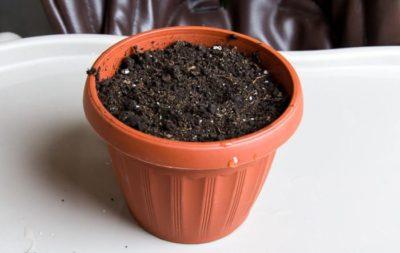

It is not worth replanting a home rose unnecessarily, however, if the soil has changed in its appearance: for example, it has become denser, heavy, friable, or, conversely, has turned into earth dust, or if the plant has outgrown its pot, in such situations you cannot do without transplanting ...
It is necessary to transplant the flower very carefully and carefully, making sure not to damage the root system, and even better, try to preserve the entire earthen ball in which the roots are located. Then, having prepared a suitable new soil (you can use a ready-made universal soil for indoor roses), you can transplant the plant, and then put the flower in the shade. After 24 hours, the rose is rearranged closer to the light and fresh air.
In addition to these nuances of care, it is important to know if indoor roses need pruning or not. Read about it here.
How a flower reproduces
Subject to all the recommendations, caring for a room rose at home is not difficult. Immediately after the purchase, you need to pay attention to the presence of young shoots. If they are present, then in the process of transplanting the cuttings should be planted. But this is not the only way to reproduce.
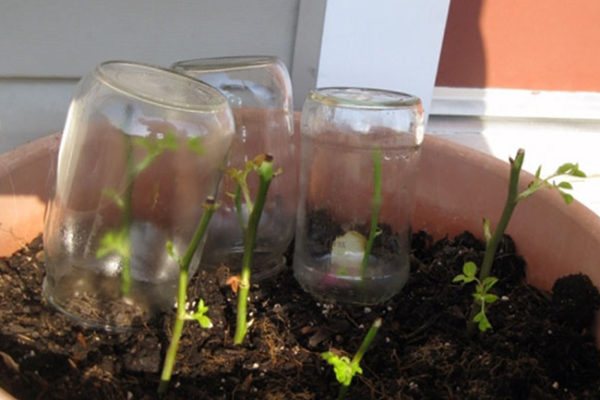

In the period from May to September, you can breed a rose using the cuttings method. For this procedure, ripe shoots are selected, on which there are 3-4 buds. As a rule, faded branches have such features. You need to cut the stalk in such a way that the indent to the kidney is at least a centimeter.
The cut twigs are placed in a pre-prepared solution (it consists of purified water, sand and peat). You cannot change the water, you just need to add it if necessary. Planting is done after the roots appear.


Breeding features
Seed propagation of roses is a long and unreliable process. Therefore, it is better to grow them from cuttings. From late spring to early autumn, semi-lignified branches 3-4 cm thick and up to 10 cm long with leaves and buds are cut from the bush.
The cuttings are placed in water for rooting and the containers are placed in a warm room. The first roots will appear after 20 days. Then the planting material is deepened into the soil moistened with a solution of Kornevin, Heteroauxin or other similar means. The first buds that appear are cut off.
Diseases of the miniature rose
Not always caring for a rose of ordinary varieties and a mix in a pot can please with a good result. It so happens that the transplant was carried out correctly, and watering is timely, but at home the plant is sick. Especially immediately after purchase, the leaves may turn yellow and crumble. In order to avoid trouble, consider the most common types of rose diseases and how to deal with them.
- Spots on the leaves. The main reason for this phenomenon is a fungus that appears due to excessive moisture in the soil and indoor air. To solve the problem, you need to remove diseased leaves, and treat the rest with antifungal drugs. Fundazo, Topsin or soap solution will help.
- Powdery mildew. The first sign of the disease is white bloom on leaves, stems and buds. It resembles white flakes or powder. The reason for the development is sudden changes in temperature and humidity. Fungicides are used to combat. The affected areas of the plant must be removed.
- Falling leaves. The main reason is non-observance of temperature, humidity and watering rules. Properly organized rose care will solve the problem.


As you can see, taking care of such a beautiful plant as a decorative rose, or a varietal mini-rose of a cordana at home is not difficult at all. It is important to adhere to the basic rules after the purchase. Remember that carelessness will lead to big problems and even death of the plant. In order not to have to deal with saving the rose, it is better to follow all the care recommendations.
What are the possible problems with leaving and what to do in this case?
You need to not only buy a room rose and take care of it, but also know how to save it in case of problems:
- One of the most common problems when growing a home rose is the appearance of spider mites. The reason for this is often excessive humidity or high temperature in the room, over-watering, as well as insufficient ventilation and, as a result, lack of fresh air.
- If the leaves of a room rose just start to crumble or dry out, it is advisable to make sure that the plant receives enough light and water, especially during the heating season (read about the reasons for the drying of leaves and buds and treatment here).
You can try gently rinsing it with a warm shower to make sure there are no harmful insects.
Read more about how to bring roses to life at home if you have problems, read here.
Correct and attentive care of this whimsical, but such a beautiful plant as a miniature home rose will help turn a room into a real blooming garden filled with brightness, beauty and aroma of this wonderful flower, which is rightfully considered one of the most adorable and charming plants.
Types, photos and names
There are a large number of varieties, they all differ in appearance and in the way of care. When buying a flower, you should not only know how to care for it, but also take into account that The scent of indoor roses can cause headaches and is dangerous for allergy sufferers. For this reason, plants are not recommended for bedrooms.
Bengal rose


The plant was first brought from China, and later from Belgium. The flower does not grow more than 60 cm, has pointed leaves and slightly flattened flowers of a red, yellow, snow-white or pink hue. Almost continuous flowering, weak smell.
Miniature rose
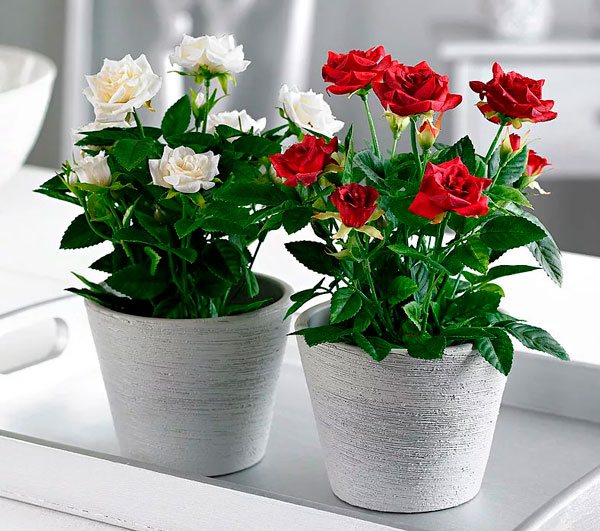

Rosa minima grows no more than 30 cm in length... The foliage is glossy, small, and the flowers are white, dark red, purple, combined into inflorescences. The petals are fringed, and the bushes are quite lush. Some types of dwarf roses have a pronounced aroma. Flowering begins in May and continues until frost.
Baby carnival
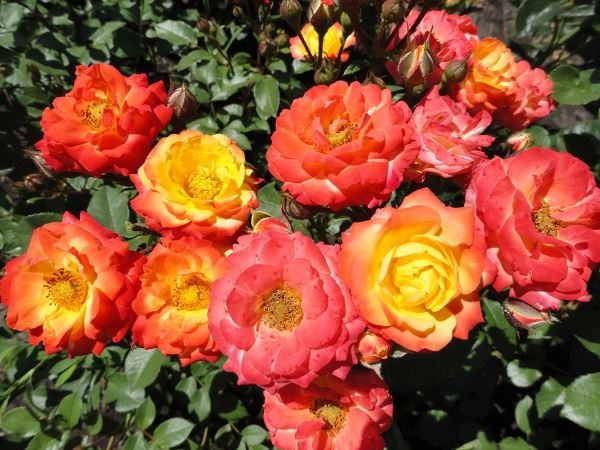

The height of the variety of bushes up to 50 cm, plant tolerates winter well and is disease resistant... The flowers are double, yellow-pink or red-orange. The aroma is poorly expressed.
Pixie
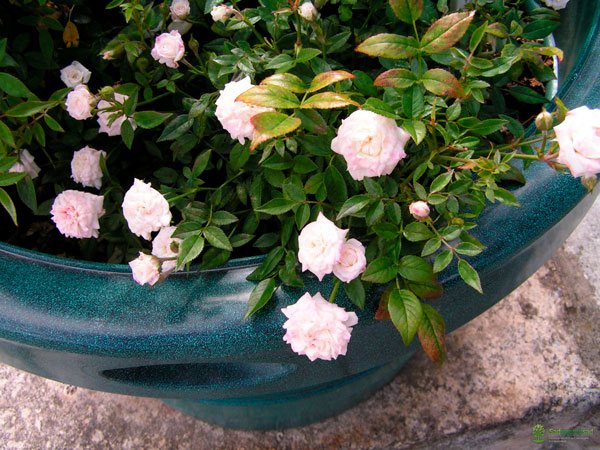

Rose Pixie is frost resistant, blooms for a long time... The height of the bushes does not exceed 40 cm. There are few thorns, many buds with fringes, they are snow-white in color with a pink base, the leaves are not large. The aroma is weak.
Eleanor


Rose of the Eleanor variety has fringed, coral-pink flowers up to 3 cm, which can grow in inflorescences, grouping in several pieces. The shrubs stretch up to half a meter in length, have a slight odor.
When and how it blooms
Very often in stores, roses bloom in winter, disrupting the normal cycle. This is due to the introduction of drugs that stimulate flowering.
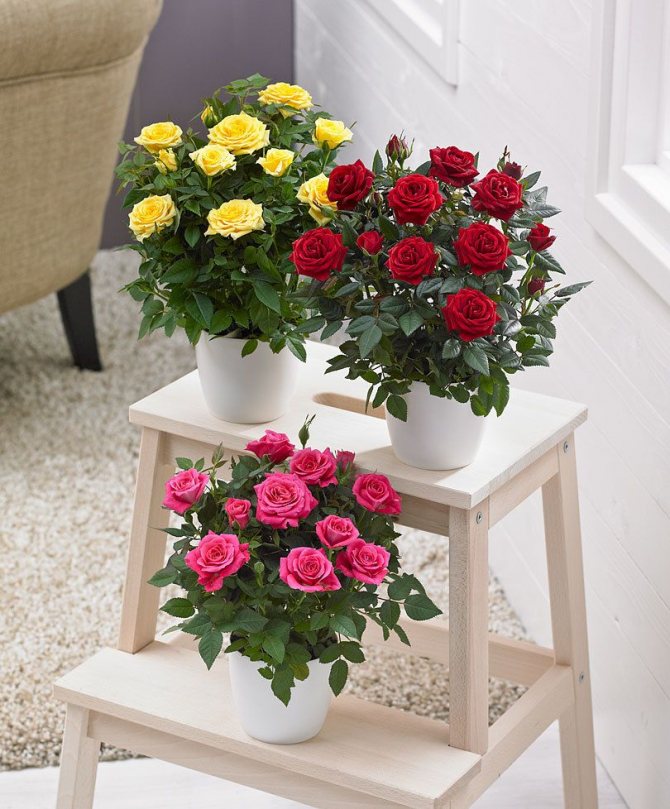

Blooming indoor roses in the interior
Having settled at home, the flower will restore the natural course of processes.
Flowering period
Individual species of this plant bloom in different ways. The flowering period depends not only on the species, but also on when and where it was bred.
Usually, flowering is observed in spring and summer, since the rose is a heliophyte (light-loving plant), under favorable conditions it can bloom in winter. In the southern regions, it blooms once every three months and even more often, if comfortable conditions are created, the roses will bloom every 2 months, from spring to autumn.
The small flowers of some varieties are completely odorless, others exude a strong aroma. The flower lasts about two weeks.
Additional Information. Usually indoor rose flowers do not cause allergic reactions.
Care changes
When flowering begins, roses require more frequent watering, purchasing and fertilizing once a week.
About the plant
Potted rose is an ornamental shrub plant from the Pink family. The main difference between this species is its compact size, which makes it convenient to grow indoors. The height of the bush usually does not exceed 35-45 cm.
The history of indoor rose cultivation has a rich history. Even in tsarist times, it was popular to grow varieties of tea roses at home. Hybrids of her Chinese "relative" could often be found in Soviet times. The plant was distinguished by large, lush flowers.
Today there are a lot of varieties of potted "beauties". They are subdivided into the following subgroups - Miniature, Mini-Flora and Polyantha. Varieties of small polyanthus and border roses with small flowers, patio roses, which became widespread at the sunset of the twentieth century, are very popular.They came to apartments and houses from the miniature cobbled courtyards that gave them their name.
In addition, breeders have bred many varieties specifically for indoor cultivation. For example, roses from the Danish trademark Cordana. The most demanded representatives of the miniature “family” are Palace and Patio-hit varieties. And, of course, one cannot fail to note the Party roses - the height of these babies does not exceed 14 cm.
What to do after a rose bloom
If you want to keep the rose at home, then it needs to arrange a cool winter. And in the spring, cut the bush somewhere in half so that it gives new shoots. In this way, the height of the plant can be controlled.
I planted my miniature roses, bought in early spring, in large pots in the summer and sent them to the dacha. They bloomed there all summer. In the fall, at the end of October, I pulled them out of the pots and dug them in the garden, covering them with earth on top. I think everything will be fine with them. In the spring I will plant it in pots again.
Useful properties of a home rose
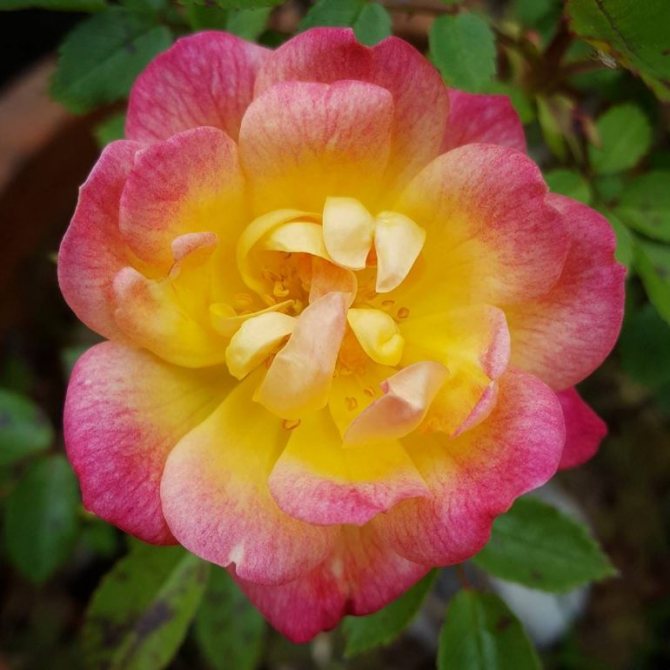

Homemade rose is a valuable raw material for the preparation of medicinal products that improve the functioning of the whole organism. Petals are a storehouse of vitamins and minerals. They are used to prepare infusions, decoctions, ointments, teas, extracts. Used in cooking and winemaking.
Rose oil improves immunity, restores cells, is used in cosmetology and perfumery. Breathing in the scent is soothing and relaxing. The contemplation of a blooming rose causes aesthetic pleasure.
Top dressing
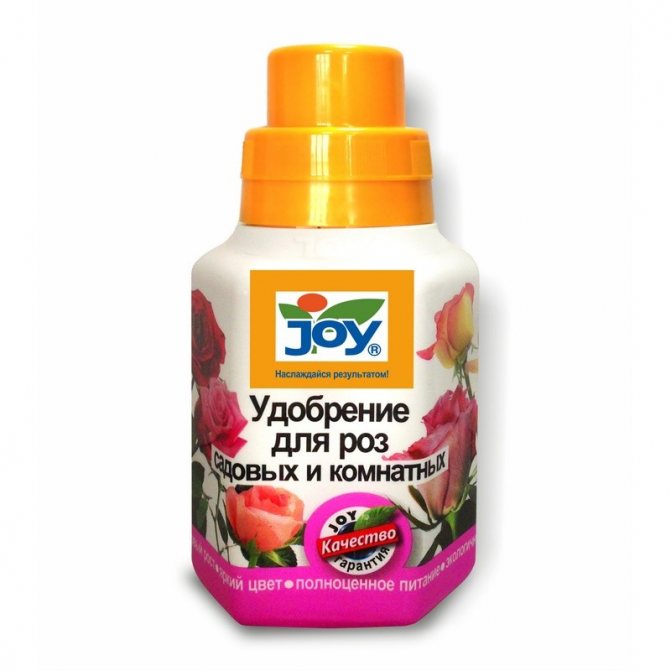

All flowering plants spend a lot of energy for the entire flowering period, drawing most of the supply of nutrients from the soil. In the case of roses, for this reason you need to feed the plants from March to October.
Any complex, universal fertilizers, as well as organic mixtures are suitable.
In spring, plants are especially responsive to foliar fertilization.
During the period of active growth, roses should be fed every 8-10 days. It is best to alternate organic and complex blends.
Fertilizers for a rose are needed until the end of flowering. And an important rule: at the end of summer and autumn, nitrogen must be completely excluded from the composition of fertilizing.
Nuances for different seasons
- In the spring the overwintered plant produces many young leaves, and then buds. Roses love south or southeast windows. Plants are placed on window sills in February, feeding begins every two weeks. It is important to observe the humidity regime.
- In summer they bloom best outdoors, such as on an open balcony. It is necessary to ensure that the containers in which the plants are planted do not overheat in the sun. If you have a summer cottage, you can plant pink bushes in flower beds or place flower pots on an open veranda.
The main thing is not to forget about timely watering, since in the open air the soil in pots dries quickly due to the wind. - In autumn cut off excess branches and transfer the plants to the premises. Roses need a dormant period during the cold season. Transplanting adult plants in the fall is not recommended. Better to do it in the spring.
- In winter roses need peace. Sometimes they winter well on cool windowsills, but it is even better to transfer them to a warmed balcony, wrapping the pots with thermal insulating material.
Does the rose bloom at home?
Blooming is the main quality for which the rose is valued... Achieving a rose bloom is relatively easy. Another question is how to improve the quality and duration of flowering. There are some common truths for this:
- The cooler the summer, the longer the roses bloom. If the bushes are placed in the shade, where the temperature is almost always kept in the region up to + 20Co, then roses will delight with flowers most of the summer.
- After watering and spraying, you need to remove all drops from the buds, otherwise they will crumble faster.
- If treatment is required for pests or diseases, it is not recommended to increase the doses prescribed to manufacturers (it seems to many that, since roses are grown exclusively for decorative purposes, it is possible not to save poison).Otherwise, insecticides will harm the plant too.
- The better and more abundant feeding, the more optimal watering, the better and longer the bushes bear fruit.
Different varieties (We make a small overview of the most popular varieties)
Decorative rose varieties can be very different from each other. And this applies not only to the appearance, height of the bush, the abundance of greenery, but also such an important factor as aroma. It can be rich or barely noticeable.
- Angela Ripon - almost a classic rose with pale pink flowers, but smaller than garden varieties (flowers up to 4 cm in diameter). When flowering, the cultivar emits fragrant, persistent aromas. Bushes grow up to 35 cm and do not require pruning.
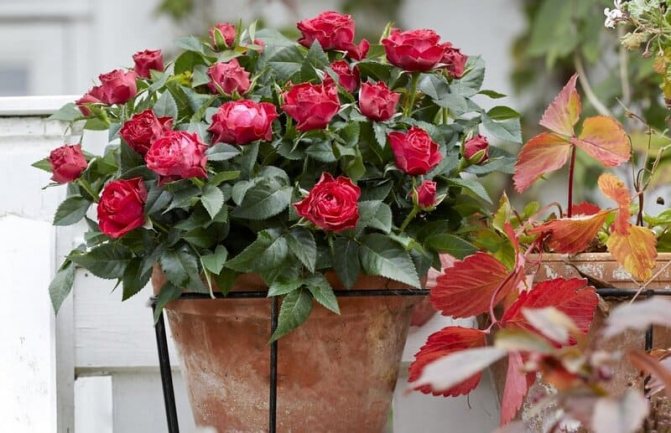

- «Yellow Doll» - one of the oldest hybrids, which smells distinctly when flowering, and many flowers with a pale yellow tint are formed on the bush. The variety has earned popularity due to the abundance of petals in the bud (up to 50 per flower).


- «Green Ice»... On this variety, flowers are tied in white with a clearly guessed green tint. The flowers do not smell much, but the most important features of the variety are tall bushes of the correct shape (up to 60 cm), extreme resistance to diseases.


Output
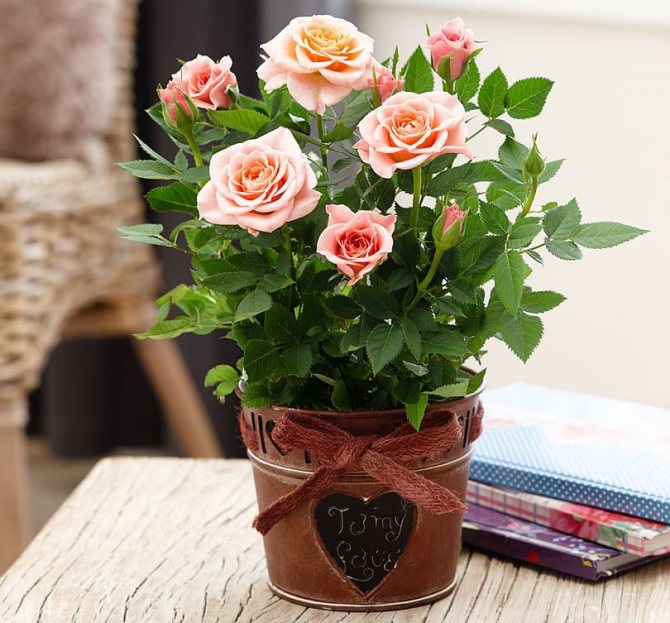

On the one hand, it may seem that opinions about indoor roses are completely true - it is difficult to care for a plant, it reacts to the slightest unfavorable factors.
However, another opinion is also relevant. If you comply with the necessary conditions (and there are many of them, but they are feasible), then the decorative rose will definitely become a worthy decoration of a garden or a flower lover's room, it will bloom for a long time, abundantly and with high quality, please the eye and every year bring pride in the work done.
A bit of history
The rose belongs to the Rosaceae family, is distinguished by fragrant flowers and the presence of thorns on the stem. Indoor specimens began to be grown back in ancient times, for this the bushes from the yard were transplanted into large flowerpots and brought into the room. Most often, they tried to protect the specimens brought from the southern regions, which were donated to persons of royal blood.
The matchmaking of princes and kings from warm countries did not pass without roses, they were like harbingers of the most serious intentions. White or pale pink flowers were intended for princesses, as a symbol of youth, perfection and purity. For widowed brides, red varieties were most often sent as gifts.
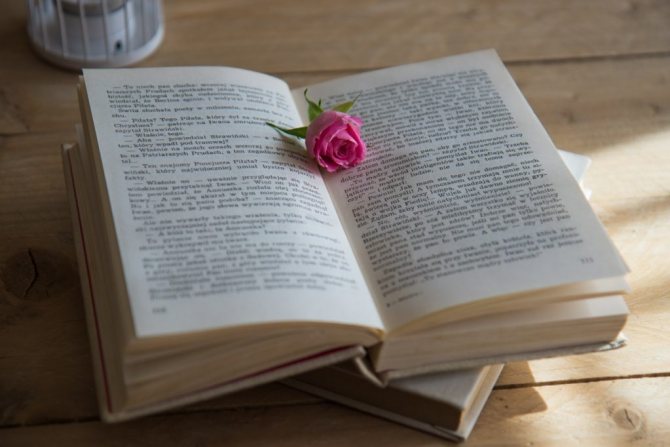

At the end of the Middle Ages, breeders of that time began to breed roses with more varied colors.
Capricious brides demanded more exotic gifts from the grooms, and they, in turn, made every effort to please their beloved. To date, there are more than a hundred varieties of home roses, breeders are breeding more and more exotic ones with unusual colors of flowers. It is much easier for today's gentlemen to please their beloved; roses of a wide variety of colors and shades are on sale.
The palette is simply amazing, blue, purple and even black flowers look quite unusual on the windowsills of apartments. Thornless varieties are especially popular, but the smell of the flower will be slightly different.
back to menu ↑
See also: Pineapple is the most famous tropical fruit: description, planting and growing at home, dessert recipes + Reviews


